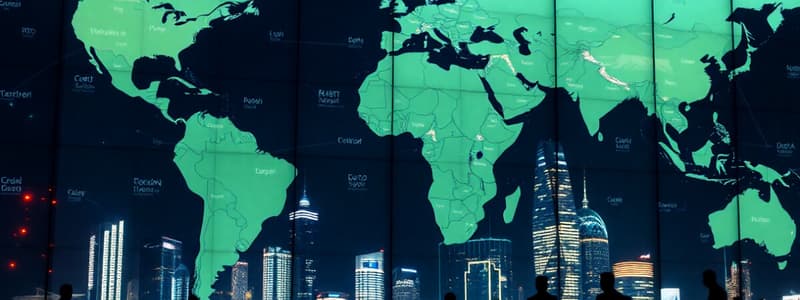Podcast
Questions and Answers
Which of the following is NOT a key characteristic of a Multinational Enterprise (MNE)?
Which of the following is NOT a key characteristic of a Multinational Enterprise (MNE)?
- Engaging in cross-border operations
- Having a centralized management only (correct)
- Transferring knowledge globally
- Operating in multiple countries
Which of the following best describes vertical diversification by a multinational enterprise?
Which of the following best describes vertical diversification by a multinational enterprise?
- Producing identical products in both home and host countries.
- Focusing on research and development activities only.
- Expanding into completely unrelated markets.
- Foreign subsidiaries producing intermediate goods for final products. (correct)
Horizontal MNEs control different stages of production across countries.
Horizontal MNEs control different stages of production across countries.
False (B)
International joint ventures generally lead to increased control and simple organizational structures for the partner companies.
International joint ventures generally lead to increased control and simple organizational structures for the partner companies.
How do MNEs contribute to global economic integration?
How do MNEs contribute to global economic integration?
What is the primary effect of labor migration on global output?
What is the primary effect of labor migration on global output?
MNEs account for a significant share of global ________, facilitating economic growth and integration.
MNEs account for a significant share of global ________, facilitating economic growth and integration.
A key characteristic of a multinational enterprise is a high ratio of foreign to total ______.
A key characteristic of a multinational enterprise is a high ratio of foreign to total ______.
Match the following MNE types with their descriptions:
Match the following MNE types with their descriptions:
Which of the following is a potential disadvantage associated with MNEs?
Which of the following is a potential disadvantage associated with MNEs?
Match the term with its description:
Match the term with its description:
Which of the following is a primary motive for companies to engage in Foreign Direct Investment (FDI)?
Which of the following is a primary motive for companies to engage in Foreign Direct Investment (FDI)?
MNEs always operate with a decentralized management structure.
MNEs always operate with a decentralized management structure.
Give an example of a prominent MNE and their global business.
Give an example of a prominent MNE and their global business.
Globalization only has positive effects and no associated drawbacks for countries and their economies.
Globalization only has positive effects and no associated drawbacks for countries and their economies.
MNEs drive the fragmentation of production processes globally through ________.
MNEs drive the fragmentation of production processes globally through ________.
When deciding between FDI and licensing, which strategy should be chosen if transportation costs are high?
When deciding between FDI and licensing, which strategy should be chosen if transportation costs are high?
What is a primary benefit of an MNE operating in multiple industries?
What is a primary benefit of an MNE operating in multiple industries?
Migration of labor from low to high productivity areas results in increased ______ output.
Migration of labor from low to high productivity areas results in increased ______ output.
What is a potential negative outcome of globalization?
What is a potential negative outcome of globalization?
What is the primary characteristic of a multinational corporation (MNC)?
What is the primary characteristic of a multinational corporation (MNC)?
Multinational corporations only operate in developed countries.
Multinational corporations only operate in developed countries.
Besides job creation, what is another key advantage that multinational corporations can bring to host countries?
Besides job creation, what is another key advantage that multinational corporations can bring to host countries?
The establishment of manufacturing plants or retail outlets by an MNC in a foreign country is known as ______ investment.
The establishment of manufacturing plants or retail outlets by an MNC in a foreign country is known as ______ investment.
Match the following terms with their descriptions related to multinational corporations:
Match the following terms with their descriptions related to multinational corporations:
Which of the following is a potential disadvantage of MNC operations in developing countries?
Which of the following is a potential disadvantage of MNC operations in developing countries?
Multinational corporations are free from the influence of political and legal factors.
Multinational corporations are free from the influence of political and legal factors.
What concept describes the integration of production processes across multiple countries by an MNC?
What concept describes the integration of production processes across multiple countries by an MNC?
The transfer of funds from a subsidiary to the parent company is known as ______.
The transfer of funds from a subsidiary to the parent company is known as ______.
Which of these is considered a driver for the growth of multinational corporations?
Which of these is considered a driver for the growth of multinational corporations?
Flashcards
Multinational Enterprise (MNE)
Multinational Enterprise (MNE)
A company operating in multiple countries with activities like research and development, manufacturing, and services. They usually have a high ratio of foreign to total sales.
Foreign Direct Investment (FDI)
Foreign Direct Investment (FDI)
When a company invests directly in a foreign country to control assets, like factories or subsidiaries. Motivated by higher returns, market access, or cost reduction.
International Joint Ventures (IJVs)
International Joint Ventures (IJVs)
A partnership between companies to combine skills and assets for specific objectives, like research or production. Often used for accessing new markets or reducing costs.
Migration and Labor Mobility
Migration and Labor Mobility
Signup and view all the flashcards
Globalization
Globalization
Signup and view all the flashcards
Vertical Diversification
Vertical Diversification
Signup and view all the flashcards
Horizontal Diversification
Horizontal Diversification
Signup and view all the flashcards
Conglomerate Diversification
Conglomerate Diversification
Signup and view all the flashcards
Comparative Advantage in FDI Decisions
Comparative Advantage in FDI Decisions
Signup and view all the flashcards
Labor Mobility Gains Formula
Labor Mobility Gains Formula
Signup and view all the flashcards
What are multinational enterprises (MNEs)?
What are multinational enterprises (MNEs)?
Signup and view all the flashcards
What characterizes a vertical MNE?
What characterizes a vertical MNE?
Signup and view all the flashcards
What defines a horizontal MNE?
What defines a horizontal MNE?
Signup and view all the flashcards
What are conglomerate MNEs?
What are conglomerate MNEs?
Signup and view all the flashcards
What are Global Value Chains (GVCs) and how do they relate to MNEs?
What are Global Value Chains (GVCs) and how do they relate to MNEs?
Signup and view all the flashcards
What is foreign direct investment (FDI) and how does it connect to MNEs?
What is foreign direct investment (FDI) and how does it connect to MNEs?
Signup and view all the flashcards
How do MNEs contribute to economic growth and integration?
How do MNEs contribute to economic growth and integration?
Signup and view all the flashcards
How do MNEs contribute to technology transfer?
How do MNEs contribute to technology transfer?
Signup and view all the flashcards
What are the key challenges faced by MNEs?
What are the key challenges faced by MNEs?
Signup and view all the flashcards
What are some ethical concerns associated with MNE operations in developing countries?
What are some ethical concerns associated with MNE operations in developing countries?
Signup and view all the flashcards
What is a multinational company?
What is a multinational company?
Signup and view all the flashcards
What is Foreign Direct Investment (FDI)?
What is Foreign Direct Investment (FDI)?
Signup and view all the flashcards
What is an International Joint Venture (IJV)?
What is an International Joint Venture (IJV)?
Signup and view all the flashcards
What is Migration and Labor Mobility?
What is Migration and Labor Mobility?
Signup and view all the flashcards
What is Vertical Diversification?
What is Vertical Diversification?
Signup and view all the flashcards
What is Horizontal Diversification?
What is Horizontal Diversification?
Signup and view all the flashcards
What is Conglomerate Diversification?
What is Conglomerate Diversification?
Signup and view all the flashcards
What is Comparative Advantage in FDI Decisions?
What is Comparative Advantage in FDI Decisions?
Signup and view all the flashcards
What is the Labor Mobility Gains Formula?
What is the Labor Mobility Gains Formula?
Signup and view all the flashcards
What is Globalization?
What is Globalization?
Signup and view all the flashcards
Study Notes
Multinational Enterprises (MNEs)
- Definition: Companies managing production or services in multiple countries. Key drivers of globalization and international integration.
- Key Characteristics:
- Global reach: Operate in numerous countries, spreading risks and accessing diverse markets; e.g., Coca-Cola.
- Cross-border operations: Engage in trade, investment, and production across borders to benefit from cost/resource differences.
- Centralized or decentralized management: Some MNEs maintain unified decision-making, others allow subsidiary autonomy.
- Diverse operations: Span multiple industries to minimize risks (e.g., Samsung).
- Knowledge transfer: Global exchange of technology, skills, and best practices.
Types of MNEs
- Vertical MNEs: Control production stages across countries (e.g., raw materials in one country, manufacturing in another).
- Horizontal MNEs: Produce identical goods/services in multiple countries for local markets.
- Conglomerate MNEs: Operate in unrelated industries across countries to diversify risks.
Role of MNEs in Globalization
- Economic Integration: Promote interdependence through trade, investment, and technology transfer.
- Global Value Chains (GVCs): Drive global production fragmentation, linking economies via trade and investment.
- FDI as a Key Mechanism: Major contributors to global Foreign Direct Investment (FDI), driving economic growth and integration.
Benefits of MNEs
- Economic Growth: Create jobs, attract investment, and integrate host countries into global value chains (GVCs).
- Technology Transfer: Introduce advanced technology and management practices to host nations.
- Market Diversification: Reduce dependence on single markets by operating globally.
Challenges of MNEs
- Exploitation Risks: Potential exploitation of labor and resources in developing nations.
- Regulatory Challenges: Navigating diverse regulations and tax systems across countries.
- Impact on Local Economies: Can dominate local markets, influencing policies and creating dependencies.
Prominent Examples
- Coca-Cola: Operates across 200+ countries with a centralized management structure for consistent branding.
- Samsung Electronics: Diversified across electronics, shipbuilding, and finance to minimize risks.
- Toyota: Sets up production plants globally to optimize costs and adapt to specific markets.
Key Insights for Exam Prep
- Understand the different MNE structures (vertical, horizontal, conglomerate).
- Focus on the dual role of MNEs: globalization drivers and economic integration facilitators via FDI and GVCs.
- Discuss both benefits (economic growth, technology transfer) and challenges (exploitation, regulatory hurdles) of MNE operations.
Studying That Suits You
Use AI to generate personalized quizzes and flashcards to suit your learning preferences.




